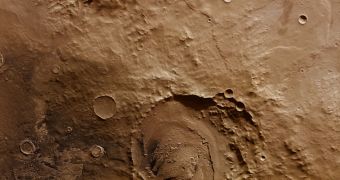Expert at the European Space Agency (ESA) recently published the results of a detailed investigation they conducted on a large impact crater basin on the surface of the Red Planet. The structure, called Schiaparelli, provides some interesting clues about our neighboring planet's past climate.
Over the past decade or so, our Mars knowledge database has increased explosively, as the result of tremendously-successful and enduring missions carried out by ESA and the American space agency.
Above the planet, the Mars Global Surveyor, the Mars Odyssey, the Mars Reconnaissance Orbiter (all NASA spacecraft) and the European-built Mars Express, conducted observations at scales never before achieved for another planet except our own.
The Odyssey managed to determine that Mars has ice sheets at its poles, buried underneath a thin layer of red dust, and was able to analyze radiation levels throughout the planet. For the past six years, it has been creating highly-detailed maps of the planet's surface.
On the surface, the twin Mars Exploration Rovers Spirit and Opportunity carried out close investigations of the planet's geology. The Phoenix Mars Lander managed to actually land in the middle of Martian ice sheets in 2008.
Through these missions, planetary and climate scientists now know that powerful winds blast on Mars at regular intervals, and also that liquid waters once formed rivers there. A full-blown ocean also existed in the northern hemisphere billions of years ago.
As such, the landscape features that ESA found on the northwestern rim of the Schiaparelli impact basin surprised no one. They were all produced by the combined effects of water and wind, but they would have caused quite a stir if discovered a few decades ago.
The eastern Terra Meridiani region, which is located at the Martian equator, is the starting point if you want to see Schiaparelli by telescope. The basin, which is some 460 kilometers wide, can be seen in the eastern part of the region.
In the new images, “evidence for water can be seen in the form of dark sediments that appear on the floor of Schiaparelli, resembling those deposited by evaporated lakes on Earth,” ESA experts say.
“The interior of Schiaparelli has been modified by multiple geological processes, including the fall of ejecta blasted upwards by the initial impact, flows of lava to create the smooth plains, and watery sediments,” they add.
The central areas of the crater appear to be “partially composed of rounded light-colored mounds. Dark wind-borne material has accumulated in the southern portion of the crater,” the team concludes.

 14 DAY TRIAL //
14 DAY TRIAL //